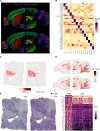Seamless integration of image and molecular analysis for spatial transcriptomics workflows
- PMID: 32664861
- PMCID: PMC7386244
- DOI: 10.1186/s12864-020-06832-3
Seamless integration of image and molecular analysis for spatial transcriptomics workflows
Abstract
Background: Recent advancements in in situ gene expression technologies constitute a new and rapidly evolving field of transcriptomics. With the recent launch of the 10x Genomics Visium platform, such methods have started to become widely adopted. The experimental protocol is conducted on individual tissue sections collected from a larger tissue sample. The two-dimensional nature of this data requires multiple consecutive sections to be collected from the sample in order to construct a comprehensive three-dimensional map of the tissue. However, there is currently no software available that lets the user process the images, align stacked experiments, and finally visualize them together in 3D to create a holistic view of the tissue.
Results: We have developed an R package named STUtility that takes 10x Genomics Visium data as input and provides features to perform standardized data transformations, alignment of multiple tissue sections, regional annotation, and visualizations of the combined data in a 3D model framework.
Conclusions: STUtility lets the user process, analyze and visualize multiple samples of spatially resolved RNA sequencing and image data from the 10x Genomics Visium platform. The package builds on the Seurat framework and uses familiar APIs and well-proven analysis methods. An introduction to the software package is available at https://ludvigla.github.io/STUtility_web_site/ .
Keywords: 3D; Data analysis; Genomics; Image processing; R-package; Software; Spatial transcriptomics; Transcriptomics; Visualization.
Conflict of interest statement
J.L is a scientific advisor at 10x Genomics Inc., which holds IP rights to the ST technology.
Figures


References
-
- Queen R, Cheung K, Lisgo S, Coxhead J, Cockell S. Spaniel: analysis and interactive sharing of spatial transcriptomics data. bioRxiv. 2019:619197..
MeSH terms
LinkOut - more resources
Full Text Sources
Other Literature Sources

